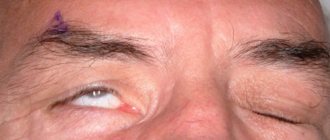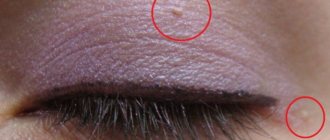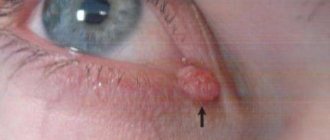It is not difficult to remove traces of crying. We have collected for you some useful tips and effective skincare products that can help you cope with teary eyes.
Tears can be different. They come in handy and moisturize your eyes while you work at the computer or write an Instagram post on your smartphone. Tears become our protectors when dust suddenly rises outside and the wind blows in our faces. They fight germs that can get into the eyes and cause inflammation. And tears can also be a reflection of our feelings: pain, fatigue, sadness and other emotions.
In the case of emotional crying, too many tears are produced, the liquid gets into the nose and out. And the mucous membranes around the eyes absorb accumulated tears - this can be seen from swollen eyelids. In general, the appearance after such an expression of feelings does not change for the better. We will tell you what you can do right now with teary eyes and what you can do before bed if you have time to spare.
Symptoms of puffy eyes
Experts consider two options for swelling: when the eyelids, conjunctiva, orbits or subcutaneous tissue under the eyes swell. Both or one eye may swell, most often without additional symptoms. Unilateral swelling in the absence of other symptoms is usually not a cause for concern. But if there is severe swelling of the upper and lower eyelids (on one or both sides), it is worth checking your health. Along with swelling, the following symptoms may appear:
- limited vision (especially due to severe swelling);
- profuse lacrimation;
- photophobia;
- feeling of dryness;
- peeling of the skin.
Sometimes, with severe swelling, mucous discharge appears. They may have a sticky consistency, be wet or dried out. Swelling of the eyelids can also be accompanied by pain, redness, and irritation of the mucous membrane.
Compresses and masks
Compresses for tear-stained eyes are more effective than lotions, but they will take more time.
Baked mashed potatoes, if applied warm, will dilate blood vessels, relieve accumulated liquid, reducing swelling.
Cool 2-6 spoons for 15 minutes. in the refrigerator and press lightly onto your eyes. Keep until the metal warms up. If necessary, replace with other chilled spoons.
Chilled milk eliminates dark circles. Cotton pads are soaked in cold milk and applied to closed eyes, changing to others as they warm up. Perform the procedure for 10 minutes.
Milk can be replaced with chilled sparkling drinking water.
Soak green tea bags in cold water and add ice. When the cubes melt, use the soaked lotions.
Keep a compress of strongly brewed black tea for 10 minutes. Relieves redness and removes circles.
Large-leaf green tea is brewed, filtered, and the leaves are wrapped in cloth and applied to the eyes, leaving for 10 minutes. Afterwards they wash themselves using tea leaves.
Beat the egg whites into a foam and apply to closed eyes. Wash after the foam has dried.
Make a puree from washed parsley, put it in gauze bags and make a compress. Remove after heating. To enhance the result, add cold sour cream to the parsley.
Apply for 5 minutes. thin slices of fresh cucumber or raw potatoes to swollen eyes. Replace plastics with fresh ones 3 times.
Peel 2-3 cucumbers, remove seeds and grind into puree. Add lemon juice. Fill gauze bags with the mixture and apply to the swelling three times for 15 minutes.
Mix apple and cucumber into puree; they will reduce swelling and help moisturize the skin.
Peel and grate raw potatoes. Also fill gauze bags and apply to swollen, tear-stained eyes. Lie down, relax, remove after 10 minutes. Use cold water for washing.
Rosemary essential oil relieves inflammation. Add 1 drop to olive oil (1 tsp). The caffeic acid in rosemary will relieve inflammation. After 1 min. blot with paper napkins or cotton pads.
Causes leading to swelling of the eyes
Short-term swelling, which goes away quickly and independently, is usually not associated with external factors, diseases, or physiology. More often it is caused by the following factors:
- poor nutrition (drinking large amounts of liquid before bed, drinking alcohol, addiction to smoked meats, spicy, salty foods);
- stress;
- cry;
- violation of wearing contact lenses;
- visual stress;
- individual characteristics of the body;
- violation of the work and rest schedule;
- bad habits;
- constant lack of sleep.
Other subjective symptoms of eyelid swelling include a burning sensation, blurred vision, and redness of the sclera. Usually they are persistent and pronounced, which once again confirms the presence of ocular or systemic diseases.
Cold method
Cold blocks swelling and inflammation by reducing the sensitivity of nerve receptors. It constricts blood vessels, causing swelling to go away. Wrap ice cubes in a cotton towel and apply to the area under the eyes for 30 seconds.
Then the skin is allowed to warm up and applied again. It is recommended to carry out the manipulation until the swelling goes away completely.
Instead of ice, frozen fruits, vegetables or meat will help. Only all products must be wrapped in cloth.
If there is nothing frozen in the refrigerator, not even ice, place a metal spoon, previously moistened with water, in the freezer. After freezing, apply to the eyes.
Could swelling be a symptom of an allergy?
An allergic reaction is one of the common causes of swelling. This happens because mast cells release biologically active proteins to neutralize allergens. But when combined with irritants, they cause a reaction that is similar to inflammation. Hence the swelling and redness of the eyelids. Among the ophthalmological causes of eyelid swelling, the most common are:
- glaucoma;
- conjunctivitis;
- periorbital cellulitis;
- eyelid tumors;
- injuries;
- insect bites;
- thermal, chemical burns.
Often the appearance of swelling is the body’s reaction to smoke, dust and other irritants from the external environment.
Use of decorative cosmetics
If you don’t have time to use traditional methods, beauty products or massage, then swelling and redness after tears can be hidden with the help of decorative cosmetics. A high-quality concealer will easily disguise the obvious signs of recent crying. It will give the face and area around the eyes a fresh look through color correction.
A number of effective tricks:
- It is best to use a green concealer. It successfully neutralizes all redness. On the color wheel, green and red are opposite colors, so they cancel each other out perfectly. Apply concealer to problem areas and blend well with your fingers or a makeup sponge.
- Another distracting method that helps hide swelling after crying is dark blue eyeliner. This is a good tool for highlighting the whiteness of the whites of the eyes. Makeup artists recommend applying this eyeliner in a thin line. It will make the dark area of the eyelash line more expressive and distract from puffiness.
- Another way to disguise is to use pink eye shadow or blush. If this color predominates on other parts of the face, it will visually reduce the redness on the wings of the nose and around the eyes. Apply blush to your cheekbones after covering them with concealer and foundation.
You can also make your lips brighter. This emphasis on the lower part of the face will distract from tear-stained eyes.
Why does swelling occur in dry eye syndrome?
Dry eye syndrome (DES) is a pathological condition that is based on a violation of the stability of the tear film.
It provides nutrition, hydration and protection to the cornea. But when few tears are produced or their composition changes, the tear film quickly begins to evaporate. Because of this, the mucous membrane dries out, a burning sensation, itching, redness, and swelling appears.
Various reasons contribute to the development of dry eye syndrome. This could be taking antidepressants, antihistamines, working at a computer for a long time, or staying in a room with dry air. Dry eye syndrome may progress during sun exposure (summer) because too much air temperature causes tears to evaporate.
You can compensate for moisture deficiency with the help of tear substitutes. These are special drops that contain moisturizing components. But, despite the fact that they have a composition close to tears, they do not contain mucins and lipids, which help the tear film to adhere to the surface of the eyeball and maintain stability.
One of the effective ways to restore the tear film is the use of Delfanto® in capsules. They contain a record amount of antioxidants (at least 35%), which help stimulate the production of your own tears.
Treatment
Pre-hospital assistance
In case of burns, rinse the eye with running water. The use of alkalis and acids to neutralize the effects of chemicals is prohibited. For trauma patients, a bandage should be applied to provide rest and eliminate eye movements and visual strain. You cannot remove foreign bodies yourself, so as not to aggravate the damage. For all eye diseases, it is important to observe the rules of personal hygiene.
Conservative therapy
Conservative treatment tactics are determined by the cause of swelling under the eyes. The following drugs can be used:
- Painkillers
. Analgesics in drops are administered to reduce pain during the examination. Subsequently, tablet forms are prescribed. - Antibiotics
. In the first days, broad-spectrum antibacterial agents are used. After receiving the result of the microbiological study, the treatment regimen is adjusted taking into account antibiotic sensitivity. - Antiseptics
. Indicated for conjunctivitis, after removal of superficial foreign bodies. - Reparation stimulants
. Necessary for corneal damage due to wounds, erosions, post-traumatic defects. - Antihistamines
. Recommended for allergic diseases.
According to indications, parabulbar, retrobulbar, subconjunctival injections are performed. Physiotherapeutic techniques are used and eyelid massage is performed.
Surgery
Taking into account the nature of the pathology, the following surgical interventions can be performed:
- Traumatic injuries
: suturing the eyelid, conjunctiva or cornea, removal of foreign bodies of the conjunctiva and cornea, necrectomy and keratoplasty for burns. - Purulent processes
: opening of barley, dacryocystorhinostomy, vitrectomy, evisceration, enucleation of the eyeball. - Other eye diseases
: penetrating keratoplasty, corneal transplantation.
In the long-term period after injuries and purulent diseases, some patients require elimination of ptosis, correction of eversion or entropion of the eyelid, antiglaucomatous operations for secondary glaucoma, and other interventions.
What diseases can cause swollen eyes?
This symptom accompanies not only ophthalmological pathologies. It may be associated with systemic diseases. For example:
- gastrointestinal diseases;
- pathologies of the pituitary gland, thyroid gland;
- diseases of the gastrointestinal tract;
- infectious, viral diseases;
- liver and kidney diseases.
The list goes on, because there are more than 70 diseases that are accompanied by swelling of the eyelids. This could indicate problems with almost any organ.
How to remove puffiness under the eyes?
It is difficult to immediately determine the cause of swelling. But you can try to eliminate provoking factors, for example, normalize your daily routine, diet, and get rid of bad habits.
If swelling is persistent, you need to seek medical help. Only a specialist can determine the reason why the eyelids are swollen and prescribe therapy.
If there is reason to believe that swelling of the eyelids is associated with everyday factors (crying, working at the computer, sleep disturbances, etc.), you can try to cope with this problem yourself. For example, using cold compresses. Cold causes blood vessels to contract, which reduces swelling.
Sometimes chilled tea bags can help relieve swelling quickly. Tea contains caffeine, which helps remove excess fluid from tissues. Tea bags must be applied for 15-20 minutes.
You can also try to remove swelling with massage (10-15 minutes a day). You also need to get good rest. Sleep should last at least 7 hours a day, and it is advisable to go to bed at the same time.
If swelling still periodically reminds itself, then you need to seek help from a specialist. Early detection of pathologies that cause swelling of the eyelids helps prevent serious complications.
If swelling is accompanied by a burning sensation, dry eyes, itching, irritation, you should take Delfanto® capsules regularly. They help increase the production of tear fluid by 89%, due to which the cornea and conjunctiva receive natural hydration.
Washing away the effects of tears
After the crying is over, you should wash your face using cold water, gradually moving on to a contrast wash. Wash in 3 approaches after 10 minutes, without touching the soap. This will cool and invigorate, and improve blood circulation, soothing teary eyes and removing redness.
If there is no place to wash your face, carefully apply a handkerchief or napkin soaked in cold water to your eyes for 10 seconds at a time. After 5-7 minutes. the procedure is repeated.











